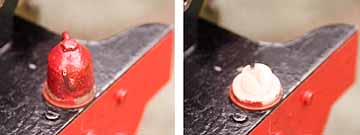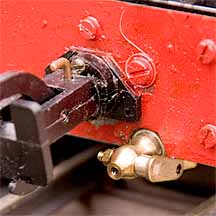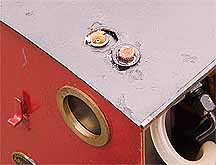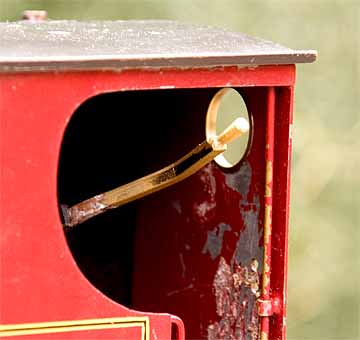
Back to Loco of the Month homepage
Back to Sidestreet Bannerworks
.
August 2009
Archangel's 2-6-2T Russell
by Marc Horovitz

Russell's history has already been examined in these pages, so there's no need to duplicate it here. You can find it under the description of Cyril Clarke's Ruskin.
The model
Archangel's model of Russell is fairly close to the prototype, as regards proportions and major details. It is a gas-fired locomotive with the traditional single-flue boiler. Backhead fittings include only a pressure gauge, which you can see by peering through the right-hand front spectacle, and a throttle. The engine has an interesting safety valve with an external spring. Under the massive steam dome, which slips off, is a filler plug for the boiler.
The lubricator is under the pilot deck. The filler protrudes through the deck and is disguised by a removable, dummy oil pot, a nice touch. There's a convenient drain on the lubricator in the form of an ornate valve below the front buffer beam. All wheels of this 2-6-2 are regaugeable (including the pilot and trailing wheels) by loosening set screws and sliding the wheels on their axles.
A very large gas tank sits in the right-side of the cab, attached to the roof. The filler valve, next to the attachment bolt, is accessible through a hole in the roof. The engine has D valves and full, working, Walschaerts valve gear, reversed from the cab.
As supplied, the engine was radio controlled, with the receiver and a pair of ancient servos stuffed into every square inch of space in the cab and a NiCad battery pack carried in a side tank. The batteries had long since died and the R/C gear in the cab gave the engine a very sloppy look. Consequently, I decided to convert the loco to manual control.
Removing the radio involved first removing the body and cab. Once this was done, the R/C components were more accessible. When all of the electronics had been discarded, what was left was a throttle-handle stub and a reach rod to the valve gear.
Making a manual throttle was a simple task of making a new handle out of brass and silver-soldering it to the stub. It's now accessible through the left-hand cab opening.
The reversing gear was not so easy. Because of the position of the gas tank, there was no room for a proper reversing quadrant. Instead, I made a low-profile slider that can be reached through the right-side cab opening. This locks into place, either full forward or full reverse, in a notched piece mounted to existing holes on the floor. The end result was a much neater cab with the controls readily at hand. A brief air test indicated that all was well, but how would it run on steam?
The run
Run day was warm and cloudy -- ideal for a gas-fired locomotive. I filled the fuel tank and the boiler and lit the fire. It took several tries before the burner would consent to stay lit, but once it did all was good. When a little pressure showed on the clock, I opened the throttle bit, then opened the lubricator drain valve to blow out the lubricator. Once done, I closed the throttle and the valve, then filled the lubricator with steam oil.
When pressure was up to about 35 pounds, I opened the throttle. After a couple of false starts, this lovely engine moved off all on its own -- no pushing necessary. From that point on it ran beautifully, lap after lap, under perfect control. You couldn't ask for more. Speed was easily controlled with the new throttle lever. I felt a little guilty for not hanging a train on the end to give it something to do, but it was so nice just watching it that I was happy to let it go on its own.
When the run was finally over, I closed the throttle and opened the lubricator valve again, using it as a blowdown. Only a few drops of oil were left anyway. If only all runs could be like this one.
Here's a movie of the engine in action. If it doesn't work, click here to go to YouTube.
|
|
|
| Builder | Archangel Models, Great Britain |
| Date built | Circa 1986 |
| Gauge | 32 mm (regaugeable) |
| Scale | 16mm |
| Boiler | Single flue |
| Fittings | Safety valve, throttle, pressure gauge |
| Fuel | Butane |
| Blow-off pressure | 45 psi |
| Cylinders | Two, double acting, D-valve |
| Reversing gear | Walschaerts |
| Lubricator | Displacement |
| Weight | 8 lb., 0 oz. |
| Dimensions | Length, 12-1/2"; width, 4-3/8"; height, 5-7/8" |













Back to Sidestreet Bannerworks home page
This page and its contents
Copyright Sidestreet Bannerworks, 2009
.